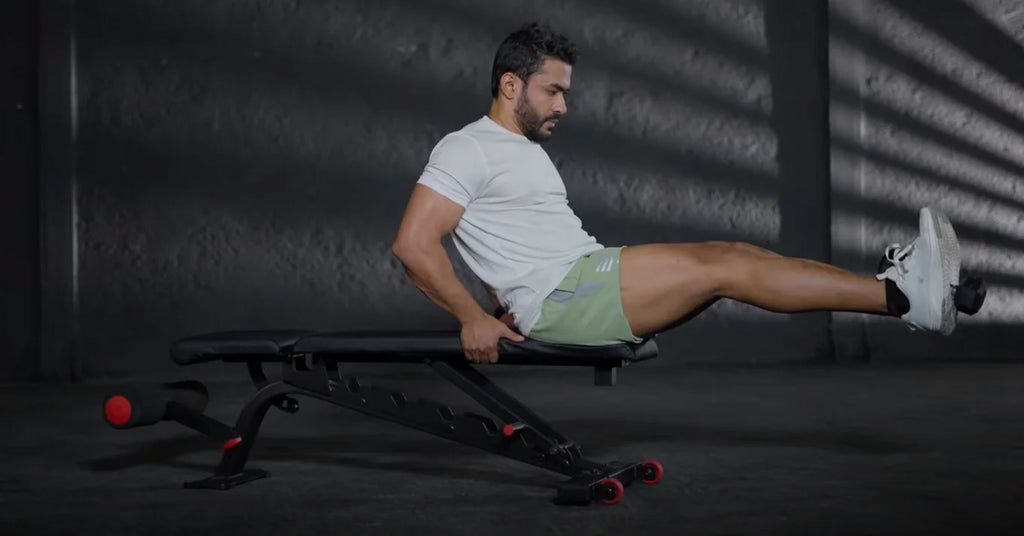Seated Dumbbell Leg Extensions for Strong Quads
The Seated Dumbbell Leg Extension is a focused exercise for strengthening the front thigh muscles (quads), requiring a weight bench (or chair) and a light dumbbell.
We believe this exercise is one of the easiest you can perform for building leg strength and aiding in knee support, and it is adaptable to various fitness levels, from beginners to advanced.

Muscles Targeted by Dumbbell Leg Extensions
The quadriceps are the stars of this exercise, but other muscles join the party too:
- Quadriceps: These are the four muscles at the front of your thigh, and they're essential for knee joint function. These muscles include the rectus femoris, vastus lateralis, vastus medialis, and vastus intermedius.
- Glutes: Composed of three muscles on the posterior aspect of the pelvis, these muscles are responsible for the movement and stabilization of the hip joint. The three muscles include the gluteus maximus, gluteus medius, and gluteus minimus.
- Hamstrings: These are the group of three muscles located at the back of your thigh, primarily responsible for knee flexion (bending) and hip extension (straightening). These muscles include the biceps femoris (which has a long head and short head), semitendinosus, and semimembranosus.
The hamstrings work together with the glutes in activities that require a hip extension, such as running, and also play an essential role in decelerating the body during running and jumping.

How to Perform Seated Dumbbell Leg Extensions
Performing seated dumbbell leg extensions is a straightforward process, but it's crucial to maintain proper form to maximize muscle activation and avoid injury.
Here's a step-by-step guide to help you get started:
STEP 1: Set Up Your Space Find a flat, stable bench and a dumbbell of appropriate weight. Remember, it's better to start light and gradually increase the weight as your strength improves.
STEP 2: Position Yourself Sit on the edge of the bench, feet flat on the floor, and legs at a 90-degree angle. Place the dumbbell vertically between your feet.
If the bench is short, you may need to increase the height with weight plates under a leg or incline the bottom seat.
STEP 3: Begin the Exercise Grip the dumbbell between your feet and slowly extend your legs until they're straight. Ensure your back remains straight and your core is engaged throughout the movement.
STEP 4: Lower the Dumbbell Slowly lower the dumbbell back to the starting position. This completes one repetition.
Here are some tips to ensure you maintain proper form and avoid injury:
- Engage Your Core: Keeping your core engaged throughout the exercise will help maintain stability and protect your lower back.
- Control Your Movements: Avoid swinging or using momentum to lift the dumbbell. Slow, controlled movements are key to effectively working your muscles and preventing injury.
- Mind Your Posture: Keep your back straight and your shoulders relaxed. Avoid rounding your back or tensing your shoulders.
- Breathe: Don't hold your breath during the exercise. Inhale as you lower the dumbbell and exhale as you lift it.
Benefits of Dumbbell Leg Extensions
Why should you consider adding this exercise to your routine? Here are some compelling reasons:
- Quadriceps strengthening: This study shows how this exercise is a fantastic way to build up your quads. Strong quads can improve your overall athletic performance and make everyday activities easier.
- Muscle isolation: Leg extensions are an isolation exercise that targetsone muscle group at a time. This can be particularly beneficial if you're looking to focus on your quads.
- Versatility: Since you only need a load and a bench, you can perform this exercise anywhere — no gym equipment is required.
- Improved balance and stability: By strengthening your quads, you'll also be improving your balance and stability, which can be beneficial in preventing falls and injuries.

Incorporating Dumbbell Leg Extensions into Your Workout Routine
Dumbbell leg extensions can be a powerful addition to your workout routine, especially if you want to strengthen your quadriceps.
But how often should you perform this exercise, and how can you combine it with other exercises for a balanced workout?
Frequency of Exercise
As a rule of thumb, incorporate dumbbell leg extensions into your routine two to three times a week.
This frequency allows your muscles adequate time to recover and grow between workouts.
Remember, rest is just as important as the workout itself regarding muscle development.
Combining with Other Exercises
Consider pairing them with compound leg exercises, like squats, lunges, leg presses, and hack squats.
This combination ensures you're working all the major muscle groups in your lower body. You can combine leg extensions with upper-body exercises for a full-body workout.
For instance, you might perform a set of leg extensions followed by push-ups or pull-ups.
Progressing Over Time As you get stronger, you must continue challenging your muscles to ensure continued progress. You can do this by gradually increasing the weight of the dumbbell you use for your leg extensions.
Another way to progress is by increasing the number of sets or reps in your workout. Remember, progression should be gradual. Listen to your body and avoid pushing yourself to the point of pain or injury.

Frequently Asked Questions
Can you do leg extensions without a machine?
Absolutely! That's the beauty of seated dumbbell leg extensions. You don't need a leg extension machine to perform this exercise.
All you need is a flat, stable bench and a dumbbell. This makes it a great exercise for home workouts or when you don't have access to gym equipment.
What muscles do dumbbell leg extensions work?
Dumbbell leg extension exercises primarily target the quad muscles, the group of muscles at the front of your thigh.
These muscles play a crucial role in knee joint function and leg movement.
However, other muscles, such as the glutes and hamstrings, also get a workout as they help stabilize your body during the exercise.
What is a dumbbell substitute for leg extension?
If you don't have a dumbbell, you can substitute it with any weighted object safely gripped between your feet. This could be a weighted bag, a kettlebell, or any load, such as a heavy book.
The key is to ensure the object is secure and won't slip during the exercise to maintain the correct form.
Unlock Your Quad Strength: A Final Thought
To wrap up, seated dumbbell leg extensions are a great way to strengthen your quadriceps. They're easy to do in a home gym or health club.
Ready to get stronger? Check out our dumbbell sets if you need a set of dumbbells to see your leg strength grow!
References
- Markus Due Jakobsen, MSc,1 Emil Sundstrup, MSc,1 Christoffer H. Andersen, PhD,1 Thomas Bandholm, PhD,2 Kristian Thorborg, PhD,3 Mette K. Zebis, PhD,4 and Lars L. Andersen, PhD. Muscle Activity During Knee‐Extension Strengthening Exercise Performed with Elastic Tubing and Isotonic Resistance. Retrieved from https://www.ncbi.nlm.nih.gov/pmc/articles/PMC3537465/




![5 Best Dumbbells for Your Home Gym Space [2025]](http://workouthealthy.com/cdn/shop/articles/5_best_home_gym_dumbbells.webp?v=1763430225&width=1080)

Leave a comment